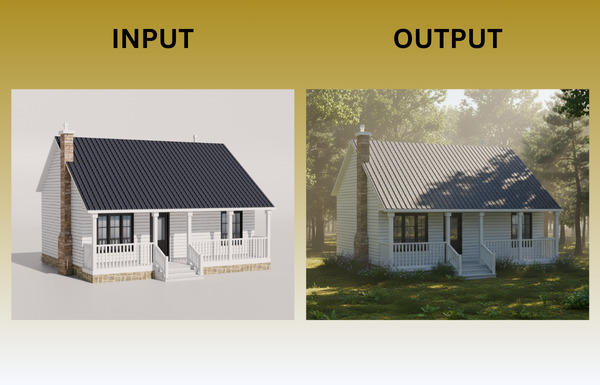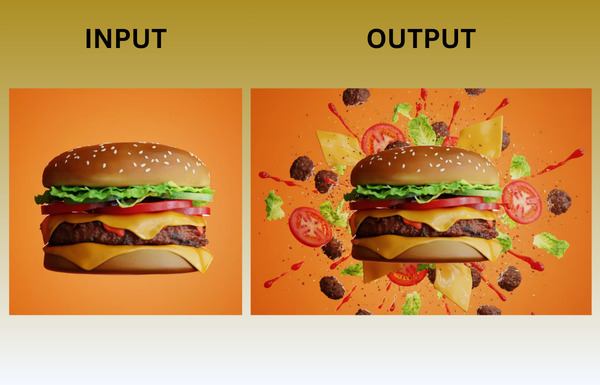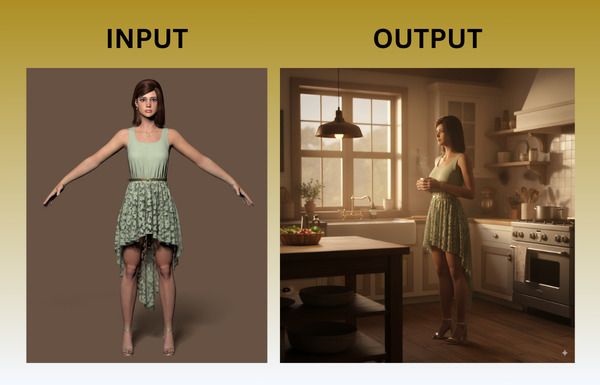AI image tools are evolving at an incredible pace and one of the most talked-about today is Google’s Nano Banana (Gemini 2.5 Flash Image). The name might sound playful, but behind it is a serious step forward in lightweight, fast image generation.
While Nano Banana is primarily designed for 2D image creation and editing, it offers a surprising range of workflows that 3D artists can actually benefit from. It’s not a replacement for 3D software – think of it as a way to unlock quick mood boards, explore styles or generate visual references in minutes. Used carefully, it helps reduce early uncertainty so you can focus your time on what matters: creating detailed, production-ready 3D work.
Why Nano Banana Went Viral
Part of Nano Banana’s sudden buzz came from its “Bandai-style” generations. Artists began using prompts to turn everyday characters and objects into toy box mockups inspired by Bandai model kits and collectibles.
These hyper-detailed, isometric-style renders – often showing packaging with accessories, instructions and glossy figures – hit the perfect blend of nostalgia and novelty. They spread quickly across Twitter/X, Reddit and design communities, turning Nano Banana into a meme and a serious creative tool.
Copy-Paste Prompt Example:
- “Create a 1 / 7 scale intelligent figurine in the picture, in a realistic style, in a real environment. The figurine is platterred on a computer desk. The figurine has a round transparent acrylic base, with no text on the base. The content on the screen is the Zbrush modeling process of this figurine. Next to the computer screen is a BANDAI-style toy packaging box with printing. The packaging features two-dimensional flat illusion.”
Here's the outcome:

Why Nano Banana Matters for 3D Artists
- Identity preservation: Keep characters and subjects consistent across edits.
- Multi-image fusion: Blend sketches, references, products and styles in one shot.
- Fast edits: Try pose swaps, outfit changes or lighting variations in seconds.
- Community energy: Creators worldwide are experimenting daily, sharing new tricks and prompt patterns.
For 3D artists, this adds up to a faster, more playful ideation stage – and a richer creative sandbox before opening Blender, Maya or Houdini.
Let’s walk through specific ways 3D artists could apply Nano Banana in their day-to-day work.
1. Building Mood boards and Style References
Every 3D project starts with inspiration. Nano Banana can:
- Generate style variations (e.g., cyberpunk, Pixar-like, ukiyo-e)
- Apply color palettes to line art.
- Test lighting setups without setting up a render scene.
It makes style exploration faster and more fun, while keeping the results useful as real references.
Copy-Paste Prompt Examples:
- “Take this character sketch and generate it in cyberpunk style, cinematic neon lighting.”
- “Apply this color palette (Image 2) to the line art (Image 1).”
- “Render the same object in three lighting setups: daylight studio, moody high-contrast, warm sunset.”
Here's an example:

2. Pre-Visualizing Environments
When you’re designing environments or architecture, rough visualization helps catch problems early. Nano Banana can:
- Turn floor plans into isometric 3D-style renders to preview spatial layouts.
- Convert street-level photos into top-down views to understand scene composition.
- Test how props or structures might look in different environments before modeling.
These outputs aren’t production-ready but are useful for quick checks and early discussions.
Copy-Paste Prompt Examples:
- “Convert this floor plan into an isometric 3D rendering of the building in daylight.”
- “From this street-level photo, generate a top-down view with the photographer position marked.”
- “Place this 3D object reference into three different environments: forest clearing, industrial warehouse, city square.”
Output example:

3. Character Exploration
Character design is another area where fast iteration helps:
- Pose Sheets: Generate multiple poses from a single reference to plan rigging requirements.
- Expression Boards: Apply facial expressions from one image to a consistent character reference.
- Clothing Variations: Swap outfits or hairstyles while preserving identity, which can guide modeling choices.
The result: more confident creative choices before you invest time in sculpting or rigging.
Copy-Paste Prompt Examples:
- “Keep identity from Image 1, apply expressions from Image 2, show 6 faces in a grid.”
- “Replace the outfit in Image 1 with clothing from Image 2, keeping pose and background.”
- “Create a pose sheet with 8 varied action poses of this character reference on a transparent background.”
Here’s the end result we got:

4. Product and Asset Mockups
For artists who create props, products or packaging, Nano Banana can support:
- Exploded views of devices and objects to communicate design intent.
- Packaging mockups for collectibles, toys or merchandise.
- Ingredient burst renders that simulate commercial photography, which can later be replicated in full 3D.
These are especially useful when working with clients who want to see a concept before investing in detailed modeling.
Copy-Paste Prompt Examples:
- “Exploded view of this [DEVICE], showing lens, housing, circuit board, screws, clean studio lighting.”
- “Turn this character photo into a LEGO-style packaging box with figures inside and accessories.”
- “Photograph this [PRODUCT] with an explosive burst of [INGREDIENTS] flying around it, studio macro style.”
Here’s a sample of how it could look:

5. Reference Cleanup and Restoration
Not all reference images are usable as-is. Nano Banana includes practical utilities like:
- Colorizing old photos.
- Repairing checkerboard transparency and missing image areas.
- Enhancing resolution for concept sketches or scanned images.
This helps prepare materials for use in texturing, sculpting or mood boards.
Copy-Paste Prompt Examples:
- “Restore and colorize this old photo while keeping historical details intact.”
- “Enhance this sketch scan into a higher resolution version, cleaning noise but preserving line detail.”
- “Repair the transparent checkerboard areas in this image and generate a full coherent picture.”
Check out our result:

6. Faster Client Communication
Nano Banana shines in the space between brainstorming and production:
- Create mockups for quick alignment.
- Get feedback on style, pose or composition before you model.
- Once approved, invest time in accurate 3D production.
It’s not just faster – this reduces rework and sets expectations clearly.
Copy-Paste Prompt Examples:
- “Take this product photo and apply a minimalist packaging style with brand colors only.”
- “Create three variations of this prop design: one futuristic, one medieval, one realistic modern.”
- “Using this character reference, generate a quick mockup in [chosen environment] to show mood.”
Here's our take:

Practical tips
- Use references wisely. 1–3 images work best (subject, outfit/material, layout). The model’s best trait is following what you show it.
- Lock the canvas. Specify ratio + resolution (e.g., “4:5, 2048×2560”) to avoid surprise crops – especially for marketplace images.
- Be precise. Use nouns like “Isometric,” “wireframe,” “exploded,” “C4D-like render,” “studio macro”.
- Iterate in small steps. Make one change at a time (pose → outfit → lighting).
- Respect privacy & IP. Don’t upload others’ faces or copyrighted designs without permission. Some viral trends raise privacy concerns.
- Treat it as pre-viz. Final client deliverables and licensed imagery should come from your 3D stack (Blender/Maya/Houdini/Substance), where you control geometry, physically-based light and material rights.
- Know limits & access. Image-generation quotas differ by plan level (“basic” vs. higher tiers). If you hit a cap, that’s expected behavior.
Conclusion
For 3D artists, Nano Banana (Gemini 2.5 Flash Image) is best understood as a creative accelerator: a tool that makes the early stages of design faster, more playful and more collaborative.
It helps 3D designers to move from sketch to concept with less friction, pre-visualize environments with confidence and communicate ideas with clients more clearly. While 2D outputs can’t replace 3D, they can make workflow smarter, lighter and a lot more fun.
Happy modeling!




Comments